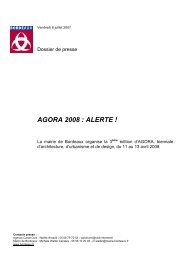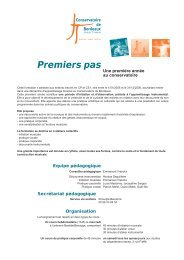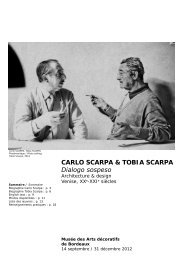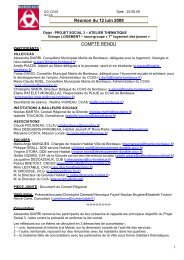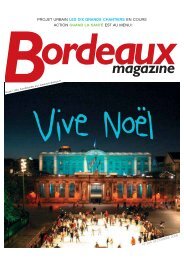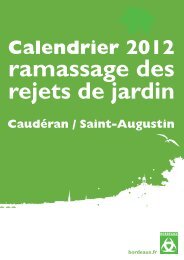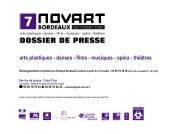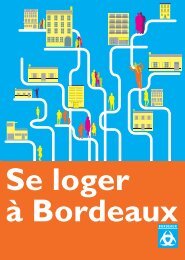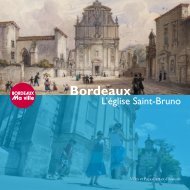Le Bordeaux de Léo Drouyn
Le Bordeaux de Léo Drouyn
Le Bordeaux de Léo Drouyn
Create successful ePaper yourself
Turn your PDF publications into a flip-book with our unique Google optimized e-Paper software.
Orientation bibliographique<strong>Le</strong>s Editions <strong>de</strong> l’Entre-<strong>de</strong>ux-Mers ontentrepris en 24 volumes la publication<strong>de</strong> l’œuvre gravé et <strong>de</strong>ssiné <strong>de</strong> <strong>Léo</strong><strong>Drouyn</strong>. <strong>Le</strong>s volumes 17 et 18 consacrésà <strong>Bor<strong>de</strong>aux</strong> sont parus en 2011.<strong>Léo</strong> <strong>Drouyn</strong> et <strong>Bor<strong>de</strong>aux</strong>, FrédériquePortelli-Zavialoff et Jacques Lacoste.<strong>Léo</strong> <strong>Drouyn</strong>, artiste et archéologue,<strong>Bor<strong>de</strong>aux</strong>, Mollat, 1997.Sites internet :www.leodrouyn.comwww.editions-entre2mers.comChronologie1816 : naissance à Izon.1835 : obtient son gra<strong>de</strong> <strong>de</strong> bachelier<strong>de</strong>s <strong>Le</strong>ttres. Il suit les cours du peintrebor<strong>de</strong>lais Jean Paul Alaux.1836-1939 : époque d’apprentissagebor<strong>de</strong>lais ; il <strong>de</strong>ssine ses premiersmonuments et paysages.1838 : mariage à <strong>Bor<strong>de</strong>aux</strong> avecAnne-Marie <strong>de</strong> Montalier.1839 : naissance <strong>de</strong> son fils, <strong>Léo</strong>n, qui<strong>de</strong>viendra un architecte <strong>de</strong> talent(1839-1918).1839-1842 : fréquente successivement<strong>de</strong>s ateliers parisiens <strong>de</strong> peintureet <strong>de</strong> gravure. Dans l’atelier <strong>de</strong> LouisMarvy, il apprend la gravure à l’eaufortequi fera sa renommée.1842 : <strong>de</strong> retour à <strong>Bor<strong>de</strong>aux</strong>, il <strong>de</strong>vient<strong>de</strong>ssinateur <strong>de</strong> la Commission <strong>de</strong>sMonuments historiques <strong>de</strong> <strong>Bor<strong>de</strong>aux</strong>.Il <strong>de</strong>ssine les monuments <strong>de</strong> lacampagne girondine.<strong>Bor<strong>de</strong>aux</strong> à la fin du XV e siècle. Vue prise en face <strong>de</strong> la porte Cailhau, 1894. AMBx Fi XL-B/5951846 : publie <strong>Le</strong> Choix <strong>de</strong>s typesles plus remarquables <strong>de</strong> l’architectureau Moyen Âge dans le département<strong>de</strong> la Giron<strong>de</strong>.
1849 : quitte la Commission <strong>de</strong>sMonuments historiques car il est endésaccord avec la politique<strong>de</strong> restauration. Il entreprendune carrière d’artiste au service<strong>de</strong> différentes institutions culturellesbor<strong>de</strong>laises.1850 : élu membre <strong>de</strong> l’Académie<strong>de</strong>s Sciences, Belles-<strong>Le</strong>ttres et Arts<strong>de</strong> <strong>Bor<strong>de</strong>aux</strong>.1851 : publie L’Album <strong>de</strong> laGran<strong>de</strong>-Sauve.1853 : nommé conservateur du Musée<strong>de</strong>s Antiques <strong>de</strong> <strong>Bor<strong>de</strong>aux</strong>.1865 : publie La Guyenne militaire.1867 : médaille d’or du salon<strong>de</strong> la gravure au Salon <strong>de</strong> Paris pour<strong>Bor<strong>de</strong>aux</strong> au soleil couchant.1870 : reçoit la Légion d’honneur.1870 : travail sur les archives <strong>de</strong> la ville<strong>de</strong> <strong>Bor<strong>de</strong>aux</strong>.1872 : prési<strong>de</strong>nt <strong>de</strong> l’Académie <strong>de</strong><strong>Bor<strong>de</strong>aux</strong>.1874 : publie <strong>Bor<strong>de</strong>aux</strong> vers 1450,ouvrage <strong>de</strong> référence sur le <strong>Bor<strong>de</strong>aux</strong>médiéval.1881-1882 : publie <strong>Le</strong>s comptes<strong>de</strong> l’Archevêché <strong>de</strong> <strong>Bor<strong>de</strong>aux</strong>.1886 : publie les Variétés girondines.1896 : meurt à <strong>Bor<strong>de</strong>aux</strong>,rue Desfourniels, le 4 août.Il est inhumé dans la sépulture<strong>de</strong> la famille d’Angla<strong>de</strong>, au cimetière<strong>de</strong> la Chartreuse.Porte Toscanan - Porte basse (détail), vers 1895. Bibliothèque municipale <strong>de</strong> <strong>Bor<strong>de</strong>aux</strong>, XXIV-13<strong>Bor<strong>de</strong>aux</strong> of <strong>Léo</strong> <strong>Drouyn</strong>Draughtsman, engraver, archaeologist,<strong>Léo</strong> <strong>Drouyn</strong> (1816-1896) left behind aconsi<strong>de</strong>rable body of work: more than5,000 drawings and 1,550 engravings.The some 500 engravings and drawingsthat <strong>Léo</strong> <strong>Drouyn</strong> <strong>de</strong>dicated to <strong>Bor<strong>de</strong>aux</strong>met with the expectations of the scientificinstitutions of <strong>Bor<strong>de</strong>aux</strong>, who wereinterested in heritage and with whomhe actively collaborated. He reproducedthe ancient monuments of the city andconjured up, beneath the 18th centurycity, a medieval city then disappearing, tothe image of the cloister of the Cathedralof St. Andrew, which he painted frombelow the wreckers’ axes. It was atthe end of his life that he un<strong>de</strong>rtookto reproduce the ancient and medievalmonuments of the town, either now lostor still visible, in pen drawings: doors,churches, squares, fortresses, ramparts.<strong>Léo</strong> <strong>Drouyn</strong> was a contemporary of the<strong>de</strong>velopment of the art of photography,but it is through his brilliant masteryof traditional techniques that he hasbeen able to pass on the memory ofnumerous monuments and urbanlandscapes, combining the precisionof an archaeologist with the romanticemotion of an artist.El Bur<strong>de</strong>os <strong>de</strong> <strong>Léo</strong> <strong>Drouyn</strong>Dibujante, grabador, arqueólogo, <strong>Léo</strong><strong>Drouyn</strong> (1816-1896) <strong>de</strong>jó una obraconsi<strong>de</strong>rable: más <strong>de</strong> 5.000 dibujosy 1.550 grabados. Los alre<strong>de</strong>dor<strong>de</strong> 500 grabados y dibujos que <strong>Léo</strong><strong>Drouyn</strong> <strong>de</strong>dicó a Bur<strong>de</strong>os respondíana las expectativas <strong>de</strong> las institucionescientíficas bor<strong>de</strong>lesas interesadasen el patrimonio, con las cualescolaboraba activamente. Reprodujo losmonumentos antiguos <strong>de</strong> la ciudad y<strong>de</strong>scubrió, tras la ciudad <strong>de</strong>l siglo XVIII,una ciudad medieval entonces en vías <strong>de</strong><strong>de</strong>saparición, a imagen <strong>de</strong>l claustro <strong>de</strong> lacatedral <strong>de</strong> Saint-André que representasometido al pico <strong>de</strong> los <strong>de</strong>moledores.Fue al final <strong>de</strong> su vida cuando sepropuso reproducir mediante dibujoscon pluma los monumentos antiguos ymedievales <strong>de</strong> la ciudad, <strong>de</strong>saparecidoso aún visibles: las puertas, las iglesias,las plazas, las fortalezas, las murallas.<strong>Léo</strong> <strong>Drouyn</strong> fue contemporáneo al<strong>de</strong>sarrollo <strong>de</strong>l arte <strong>de</strong> la fotografía,pero fue a través <strong>de</strong> un uso magistral<strong>de</strong> las técnicas tradicionales como supotransmitir el recuerdo <strong>de</strong> numerososmonumentos y paisajes urbanos,aunando la precisión <strong>de</strong>l arqueólogocon la emoción romántica <strong>de</strong>l artista.
La Bibliothèque municipale <strong>de</strong> <strong>Bor<strong>de</strong>aux</strong> consacre sa gran<strong>de</strong> exposition estivale à <strong>Léo</strong> <strong>Drouyn</strong>. Témoin <strong>de</strong>s profon<strong>de</strong>s mutations <strong>de</strong> la ville auXIX e siècle, cet artiste les a <strong>de</strong>ssinées, peintes et gravées avec la même précision que celle avec laquelle il imaginait la cité du Moyen Age. Villeobservée, ville fantasmée, c’est « <strong>Le</strong> <strong>Bor<strong>de</strong>aux</strong> <strong>de</strong> <strong>Léo</strong> <strong>Drouyn</strong> », qui croise réalité archéologique et imagination. A cette occasion, hors <strong>de</strong>s murs<strong>de</strong> la Bibliothèque, <strong>de</strong>s parcours labellisés « Ville d’art et d’histoire » appréhen<strong>de</strong>nt l’aménagement <strong>de</strong> la ville au XIX e siècle sous l’œil <strong>de</strong> l’artiste.Je vous invite à emprunter ces sentiers <strong>de</strong> découverte graphique d’une ville toujours en mutation, la nôtre.The <strong>Bor<strong>de</strong>aux</strong> City Library is <strong>de</strong>dicating its main Summer exhibition to <strong>Léo</strong> <strong>Drouyn</strong>. Witnessing the <strong>de</strong>ep changes un<strong>de</strong>rwent by the city in the19 th Century, the artist painted, drew and engraved them in as much <strong>de</strong>tail as he envisioned the medieval city. In the eye of the artist, the “<strong>Bor<strong>de</strong>aux</strong>of <strong>Léo</strong> <strong>Drouyn</strong>” is observed and dreamed as both an archaeological reality and a fantasy. For the exhibition held outsi<strong>de</strong> the library, so-called ‘cityhistory paths’ explore the 19 th Century urban planning as seen by the artist. I urge you to take these paths to graphic discoveries on our everchanging city.La Biblioteca municipal <strong>de</strong> Bur<strong>de</strong>os <strong>de</strong>dica su gran exposición estival a <strong>Léo</strong> <strong>Drouyn</strong>. Testimonio <strong>de</strong> gran<strong>de</strong>s transformaciones en la ciudad en elsiglo XIX, este artista las ha dibujado, pintado y grabado con la misma precisión que la que imaginaba la ciudad <strong>de</strong> la Edad Media. Ciudad observada,ciudad soñada, es “El Bur<strong>de</strong>os <strong>de</strong> <strong>Léo</strong> <strong>Drouyn</strong>”, que combina realidad arqueológica e imaginación. En esta ocasión, fuera <strong>de</strong> las pare<strong>de</strong>s <strong>de</strong> laBiblioteca, recorridos registrados como “Ciudad <strong>de</strong> arte y <strong>de</strong> historia” compren<strong>de</strong>n el or<strong>de</strong>namiento <strong>de</strong> la ciudad en el siglo XIX a través <strong>de</strong>lojo <strong>de</strong>l artista. Aprovecho la ocasión para invitarle a recorrer estos sen<strong>de</strong>ros <strong>de</strong> <strong>de</strong>scubrimiento gráfico <strong>de</strong> una ciudad siempre en movimiento,la nuestra.Alain Juppé, maire <strong>de</strong> <strong>Bor<strong>de</strong>aux</strong> / Mayor of <strong>Bor<strong>de</strong>aux</strong> / Alcal<strong>de</strong> <strong>de</strong> Bur<strong>de</strong>osPremier vice-prési<strong>de</strong>nt <strong>de</strong> la Communauté urbaine <strong>de</strong> <strong>Bor<strong>de</strong>aux</strong> /First vice-presi<strong>de</strong>nt of the Urban community of <strong>Bor<strong>de</strong>aux</strong> / El primer vicepresi<strong>de</strong>nte <strong>de</strong> la Comunidad urbana <strong>de</strong> Bur<strong>de</strong>osRenseignementsExposition<strong>Le</strong> <strong>Bor<strong>de</strong>aux</strong> <strong>de</strong> <strong>Léo</strong> <strong>Drouyn</strong>Du 4 juillet au 15 octobre 2011Bibliothèque Méria<strong>de</strong>ck85 cours du maréchal Juin33000 <strong>Bor<strong>de</strong>aux</strong>Tél. 05 56 10 30 00HorairesDu 4 juillet au 9 juillet et du 29 août au15 octobre : du lundi au vendredi,<strong>de</strong> 13h à 19h et le samedi, <strong>de</strong> 13h à 18h.Du 12 juillet au 27 août : du mardi auvendredi, <strong>de</strong> 13h à 19h et le samedi,<strong>de</strong> 13h à 16h.La Bibliothèque Méria<strong>de</strong>ck sera ferméeexceptionnellement du 25 juillet au6 août inclus.Commissaires <strong>de</strong> l’expositionLouis Torchet et Bernard Larrieu.AnimationsParcours-découvertes jeunes publics(7-12 ans) « Sur les pas <strong>de</strong> <strong>Léo</strong> à<strong>Bor<strong>de</strong>aux</strong>… » : tous les mercredis<strong>de</strong> 14h à 16h30 du 4 juillet au16 septembre 2011(les enfants peuvent venir accompagnés)Parcours gratuits et sur réservation audépart <strong>de</strong> l’exposition au 05 56 10 30 00.Visites guidées <strong>Le</strong> <strong>Bor<strong>de</strong>aux</strong> <strong>de</strong> <strong>Léo</strong><strong>Drouyn</strong> les mardis 5 et 19 juillet,16 et 23 août, 6 et 20 septembre,4 et 11 octobre <strong>de</strong> 15h à 17h30Parcours gratuits et sur réservation audépart <strong>de</strong> l’exposition au 05 56 10 30 00.Parcours gratuits réservés aux scolaires :tous les mardis et vendredis matin<strong>de</strong> 9h30 à 11h30 du 19 septembreau 15 octobre 2011.Contact pour les enseignants :05 24 57 53 03.<strong>Le</strong>s partenairesArchives Municipales <strong>de</strong> <strong>Bor<strong>de</strong>aux</strong>,Musée <strong>de</strong>s beaux-arts <strong>de</strong> <strong>Bor<strong>de</strong>aux</strong>,Musée d’Aquitaine, la Mission Villed’Art et d’Histoire et les Editions <strong>de</strong>l’Entre-<strong>de</strong>ux-Mers.RemerciementsLa Bibliothèque municipale <strong>de</strong> <strong>Bor<strong>de</strong>aux</strong>tient à exprimer sa plus vive reconnaissanceaux prêteurs et sa gratitu<strong>de</strong> à celles et ceuxqui ont permis que cette exposition voiele jour : La commune d’Izon, la S.H.A.S.E,le Château Laujac.Que soient aussi remerciés les prêteurs quiont souhaité gar<strong>de</strong>r l’anonymat.Couv. : Démolition en 1865 <strong>de</strong>s cloîtres etdépendances <strong>de</strong> la cathédrale <strong>de</strong> <strong>Bor<strong>de</strong>aux</strong>, 1872.AMBx. Fi XI-G/384.Couv. : Démolition en 1865<strong>de</strong>s cloîtres et dépendances <strong>de</strong>la cathédrale <strong>de</strong> <strong>Bor<strong>de</strong>aux</strong>, 1872.AMBx. Fi XI-G/384.




